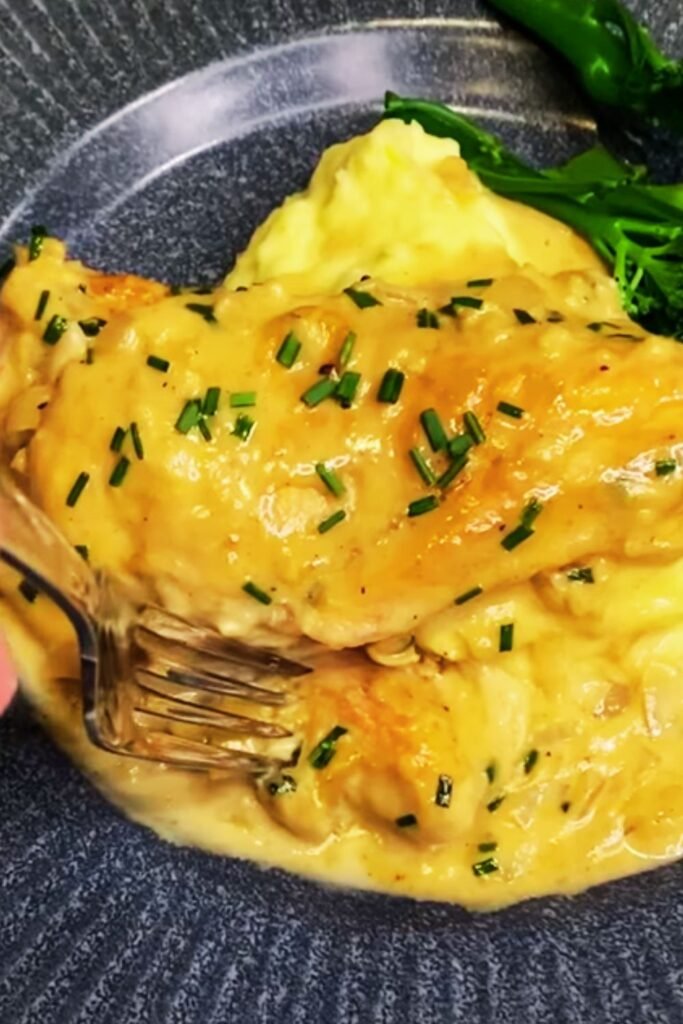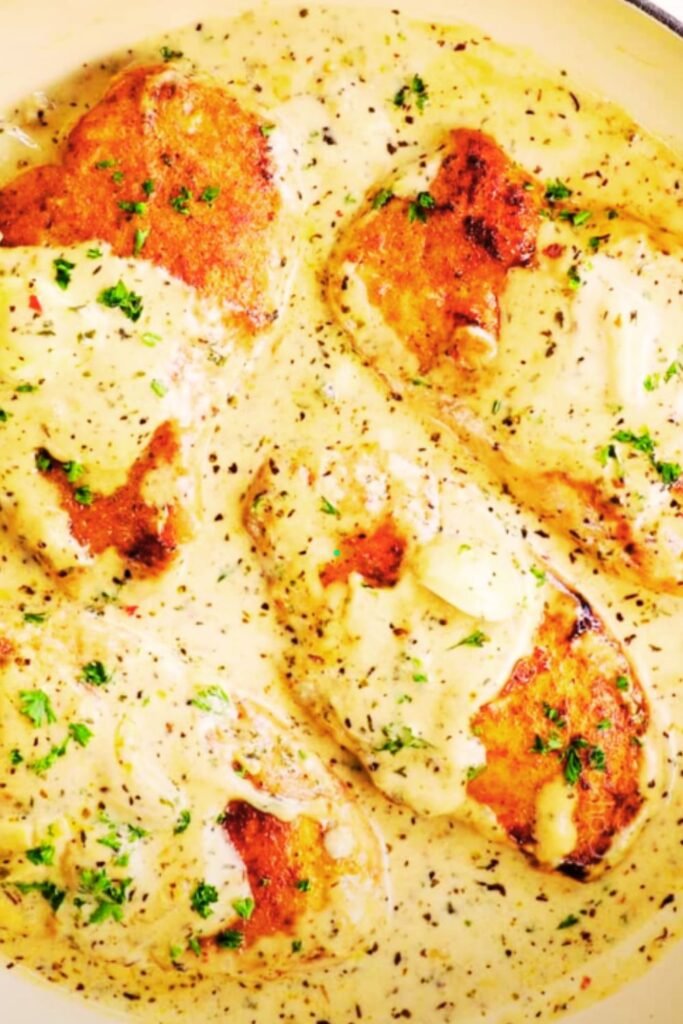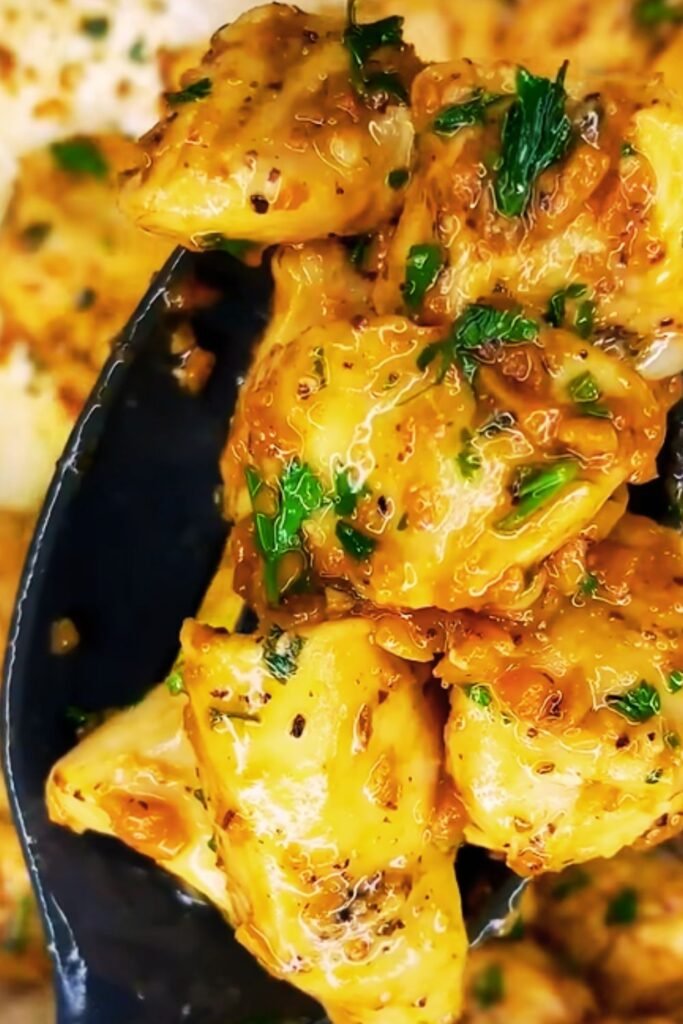There’s something magical about the aroma of herb-roasted chicken wafting through my kitchen, especially when it’s bathed in a luxurious creamy white wine sauce. I’ve been perfecting this recipe for years, and it never fails to impress both family and dinner guests. The combination of golden, crispy skin with tender, juicy meat complemented by a velvety sauce creates a restaurant-quality dish right in your own home.
This herb roasted chicken represents the perfect marriage of rustic comfort food and elegant dining. What sets this recipe apart is the careful balance of fresh herbs, the depth of flavor from proper roasting techniques, and that incredible creamy white wine sauce that ties everything together beautifully.
What Makes This Recipe Special
Herb Roasted Chicken: A cooking method that involves seasoning a whole chicken or chicken pieces with a blend of fresh and dried herbs, then roasting at high heat to achieve crispy skin while maintaining moist, flavorful meat.
Creamy White Wine Sauce: A reduction-based sauce that combines white wine with cream, herbs, and pan drippings to create a rich, flavorful accompaniment that enhances the roasted chicken without overwhelming its natural taste.
Roasting Technique: The process of cooking meat in an oven using dry heat, which creates a caramelized exterior while keeping the interior moist and tender.
I’ve discovered that the secret to achieving the perfect herb roasted chicken lies in three critical elements: proper seasoning penetration, temperature control, and timing. The creamy white wine sauce isn’t just an afterthought – it’s an integral part of the dish that transforms simple roasted chicken into something extraordinary.
Essential Ingredients Breakdown
The beauty of this recipe lies in its accessibility. Most ingredients are pantry staples, while the fresh herbs and quality white wine elevate the dish to gourmet status. I always emphasize using the best ingredients you can afford, particularly when it comes to the chicken and wine.
| Ingredient Category | Item | Quantity | Purpose | Substitution Options |
|---|---|---|---|---|
| Protein | Whole chicken | 3-4 lbs | Main protein | Chicken thighs, drumsticks |
| Herbs (Fresh) | Rosemary | 3 sprigs | Aromatic base | Dried rosemary (1 tbsp) |
| Herbs (Fresh) | Thyme | 4 sprigs | Earthy flavor | Dried thyme (1.5 tbsp) |
| Herbs (Fresh) | Sage | 6-8 leaves | Savory depth | Dried sage (1 tsp) |
| Aromatics | Garlic | 6 cloves | Flavor foundation | Garlic powder (2 tsp) |
| Aromatics | Yellow onion | 1 large | Sweetness base | Shallots (3 large) |
| Liquid | Dry white wine | 1 cup | Sauce base | Chicken broth |
| Dairy | Heavy cream | ¾ cup | Richness | Half-and-half |
| Fat | Butter | 4 tbsp | Flavor carrier | Olive oil |
| Seasoning | Kosher salt | 2 tsp | Flavor enhancement | Sea salt |
| Seasoning | Black pepper | 1 tsp | Heat element | White pepper |
| Acid | Lemon | 1 whole | Brightness | Lime |
Step-by-Step Preparation Guide
Preparing the Chicken
I always start by bringing my chicken to room temperature, which typically takes about 30 minutes. This ensures even cooking throughout. While the chicken comes to temperature, I prepare my herb mixture and preheat the oven to 425°F (220°C).
The herb preparation is crucial to my success with this dish. I finely chop the fresh rosemary, thyme, and sage, then combine them with minced garlic, salt, and pepper. Creating this herb paste allows for better adherence to the chicken skin and more even flavor distribution.

Pat the chicken completely dry with paper towels – this step is non-negotiable for achieving crispy skin. I then carefully loosen the skin over the breast and thighs by gently sliding my fingers underneath, being careful not to tear the delicate skin.
Seasoning Technique
My seasoning technique involves both under-skin and over-skin application. I spread about half of my herb mixture directly onto the meat under the loosened skin, massaging it gently to ensure even coverage. The remaining herb mixture gets rubbed all over the outside of the chicken, paying special attention to areas where the skin might be thicker.
I stuff the cavity with halved lemon, remaining garlic cloves, and herb stems. This aromatherapy from the inside adds another layer of flavor complexity that permeates the meat during roasting.
The Roasting Process
Place the seasoned chicken breast-side up on a roasting rack set inside a heavy-bottomed roasting pan. I surround the chicken with roughly chopped onions, which will later become part of our sauce base while also preventing the bottom from burning.
The initial high-heat roasting at 425°F for the first 20 minutes creates that coveted crispy skin. I then reduce the temperature to 375°F (190°C) and continue roasting until the internal temperature reaches 165°F (74°C) when measured at the thickest part of the thigh.
| Roasting Timeline | Temperature | Duration | Visual Cues | Internal Temp |
|---|---|---|---|---|
| Initial sear | 425°F (220°C) | 20 minutes | Skin browning | Not applicable |
| Main roasting | 375°F (190°C) | 35-45 minutes | Golden brown | 165°F (74°C) |
| Resting period | Room temp | 10 minutes | Juices settle | Carryover cooking |
Creating the Creamy White Wine Sauce
The sauce begins while the chicken rests. I remove the chicken from the roasting pan and tent it with foil, allowing those precious juices to redistribute throughout the meat. The roasting pan, still containing all those caramelized drippings and softened onions, becomes the foundation for our sauce.

I place the roasting pan directly over medium heat on my stovetop (using two burners if necessary). The onions get sautéed until they’re deeply caramelized, about 8-10 minutes. This step builds incredible depth in our sauce base.
Next comes the wine – I pour in the full cup and let it bubble vigorously, scraping up all those beautiful browned bits from the bottom of the pan. This deglazing process captures every bit of roasted flavor that would otherwise be lost.
Sauce Reduction and Finishing
The wine needs to reduce by about half, concentrating its flavors and cooking off the alcohol. I can tell it’s ready when the liquid looks slightly syrupy and has lost that sharp alcoholic aroma. This usually takes 8-12 minutes of active simmering.
Once the wine has reduced properly, I strain the mixture through a fine-mesh sieve, pressing the solids to extract maximum flavor. The resulting liquid goes back into a clean saucepan where I’ll finish the sauce.
The cream gets whisked in gradually, and I bring the mixture to a gentle simmer. I never let cream-based sauces boil vigorously, as this can cause curdling. The final seasoning adjustment happens here – usually a pinch more salt and a squeeze of fresh lemon juice to brighten everything up.
Carving and Presentation
Proper carving technique ensures that each serving showcases the juicy, herb-infused meat at its best. I always carve against the grain, starting with the legs and thighs before moving to the breast meat. The skin should be crispy enough to provide a satisfying contrast to the tender meat beneath.
I arrange the carved chicken on a warm platter and spoon some of the creamy white wine sauce around and over the pieces. The remaining sauce gets served alongside in a gravy boat, allowing guests to add as much or as little as they prefer.
Nutritional Profile and Health Benefits
Understanding the nutritional aspects of this dish helps me make informed decisions about portion sizes and accompaniments. While this is definitely an indulgent meal, it provides excellent protein and can be part of a balanced diet when served with appropriate sides.
| Nutritional Component | Per Serving (6 oz chicken + sauce) | % Daily Value | Health Benefits |
|---|---|---|---|
| Calories | 485 | 24% | Energy provision |
| Protein | 42g | 84% | Muscle maintenance |
| Total Fat | 28g | 36% | Satiety, vitamin absorption |
| Saturated Fat | 12g | 60% | Flavor carrier |
| Carbohydrates | 6g | 2% | Quick energy |
| Sodium | 680mg | 30% | Electrolyte balance |
| Vitamin A | 380 IU | 8% | Eye health |
| Iron | 2.1mg | 12% | Oxygen transport |
The fresh herbs in this recipe contribute antioxidants and anti-inflammatory compounds. Rosemary contains carnosic acid, which has been studied for its neuroprotective properties. Thyme provides vitamin C and has antimicrobial properties, while sage contains compounds that may support cognitive function.
Wine Pairing and Serving Suggestions
Since we’re already incorporating white wine into the sauce, it makes sense to serve a complementary varietal alongside the meal. I prefer wines with enough acidity to cut through the richness of the cream sauce while complementing the herbs.
Perfect Wine Pairings:
- Chardonnay (particularly unoaked versions)
- Sauvignon Blanc for its herbaceous notes
- Pinot Grigio for its clean, crisp character
- Albariño for its mineral complexity
For non-alcoholic alternatives, I recommend sparkling water with lemon, herbal iced teas, or even a sophisticated virgin mojito with fresh herbs that echo those in the dish.

Ideal Side Dishes:
- Roasted root vegetables (carrots, parsnips, potatoes)
- Garlic mashed potatoes to soak up the sauce
- Steamed asparagus with lemon
- Wild rice pilaf with herbs
- Simple green salad with vinaigrette
Storage and Reheating Guidelines
Proper storage ensures that leftovers maintain their quality and safety. I always separate the chicken from the sauce for storage, as they have different optimal reheating methods.
| Storage Method | Chicken | Sauce | Duration | Quality Notes |
|---|---|---|---|---|
| Refrigerator | Airtight container | Separate container | 3-4 days | Best within 2 days |
| Freezer | Vacuum sealed | Ice cube trays | 2-3 months | Sauce may separate |
| Reheating | 325°F oven | Gentle stovetop | Until 165°F | Add liquid if needed |
When reheating, I place the chicken in a covered dish with a splash of chicken broth to prevent drying out. The sauce reheats beautifully on the stovetop over low heat, though I sometimes need to whisk in a tablespoon of cream if it has thickened too much during storage.
Troubleshooting Common Issues
Over the years, I’ve encountered and solved various challenges with this recipe. Understanding these potential pitfalls helps ensure consistent success every time I make this dish.
Dry Chicken Solutions:
- Always use a meat thermometer – guessing leads to overcooking
- Brine the chicken for 2-4 hours before cooking for extra moisture
- Don’t skip the resting period after roasting
- Tent with foil if the skin browns too quickly
Sauce Problems and Fixes:
- Curdled sauce: Remove from heat immediately and whisk in cold cream
- Too thin: Simmer longer to reduce, or whisk in a butter-flour mixture
- Too thick: Thin with additional cream or chicken broth
- Lacks flavor: Adjust seasoning and add a splash of lemon juice
Seasonal Variations and Adaptations
This recipe adapts beautifully to different seasons and ingredient availability. In spring, I might add fresh tarragon or chives to the herb mixture. Summer calls for the addition of fresh basil or oregano from my garden.
Fall variations include incorporating sage more heavily and adding roasted shallots to the sauce. Winter versions might feature heartier herbs like marjoram and a touch of cream reduction with roasted garlic.
Dietary Adaptations:
- Dairy-free: Substitute coconut cream or cashew cream
- Lower sodium: Use herbs and citrus for flavor instead of extra salt
- Gluten-free: This recipe is naturally gluten-free
- Keto-friendly: Already fits most ketogenic diet requirements
Professional Tips for Success
My years of making this dish have taught me several professional techniques that make the difference between good and exceptional results. Temperature control remains the most critical factor – both in terms of cooking temperature and ingredient temperature.
I always bring cream to room temperature before adding it to hot liquids, which prevents temperature shock and reduces the risk of curdling. The wine I use for cooking is always something I’d be happy to drink – cooking doesn’t magically improve poor-quality wine.
Timing coordination is essential for serving this dish at its peak. I work backward from my desired serving time, accounting for resting periods and sauce preparation. This ensures everything comes together seamlessly.
Questions and Answers
Q: Can I use chicken pieces instead of a whole chicken? I absolutely recommend using chicken pieces if that’s more convenient for you. Bone-in, skin-on thighs and drumsticks work wonderfully with this recipe. Just adjust the cooking time to about 35-45 minutes total, and check that each piece reaches 165°F internal temperature.
Q: What if I don’t have white wine for the sauce? You can substitute chicken broth for the wine, though you’ll lose some depth of flavor. I sometimes add a tablespoon of white wine vinegar to the broth for acidity. Another option is using a dry vermouth, which actually works beautifully in cream sauces.
Q: How do I prevent the cream sauce from curdling? The key is temperature control and gradual incorporation. Always add room-temperature cream to hot (not boiling) liquids while whisking constantly. If your sauce does curdle, remove it from heat immediately and whisk in a tablespoon of cold cream to stabilize it.
Q: Can I make this recipe ahead of time? You can season the chicken up to 24 hours in advance and refrigerate it covered. The sauce can be made a day ahead and gently reheated. However, I don’t recommend fully cooking the chicken in advance, as reheated roasted chicken never quite recaptures that perfect texture.
Q: What’s the best way to ensure crispy skin? Dry skin is crispy skin! Pat the chicken completely dry before seasoning, and don’t cover it during roasting. Starting at high heat (425°F) for the first 20 minutes creates that initial crispiness. Also, make sure your oven is fully preheated before the chicken goes in.
Q: How do I know when the chicken is perfectly done? Always use a meat thermometer inserted into the thickest part of the thigh, avoiding bone contact. The temperature should read 165°F. The juices should run clear, and the leg should move easily in its socket when the chicken is fully cooked.
Q: Can I make this dish in a slow cooker? While you could adapt this for slow cooking, you’d lose the crispy skin that makes this dish special. If you must use a slow cooker, I’d recommend searing the chicken pieces in a skillet first to develop some color and texture before slow cooking.
Q: What herbs work best if I can’t find fresh ones? Dried herbs can substitute in a pinch – use about one-third the amount called for in fresh herbs. Dried rosemary, thyme, and sage all work well. Just rub them between your palms before using to release their oils and maximize flavor impact.
This herb roasted chicken in creamy white wine sauce represents everything I love about home cooking – it’s approachable yet impressive, comforting yet elegant. The combination of perfectly seasoned, crispy-skinned chicken with that luxurious sauce creates a meal that feels both special and satisfying. Whether you’re cooking for family dinner or entertaining guests, this recipe delivers consistent, restaurant-quality results that will have everyone asking for the recipe.